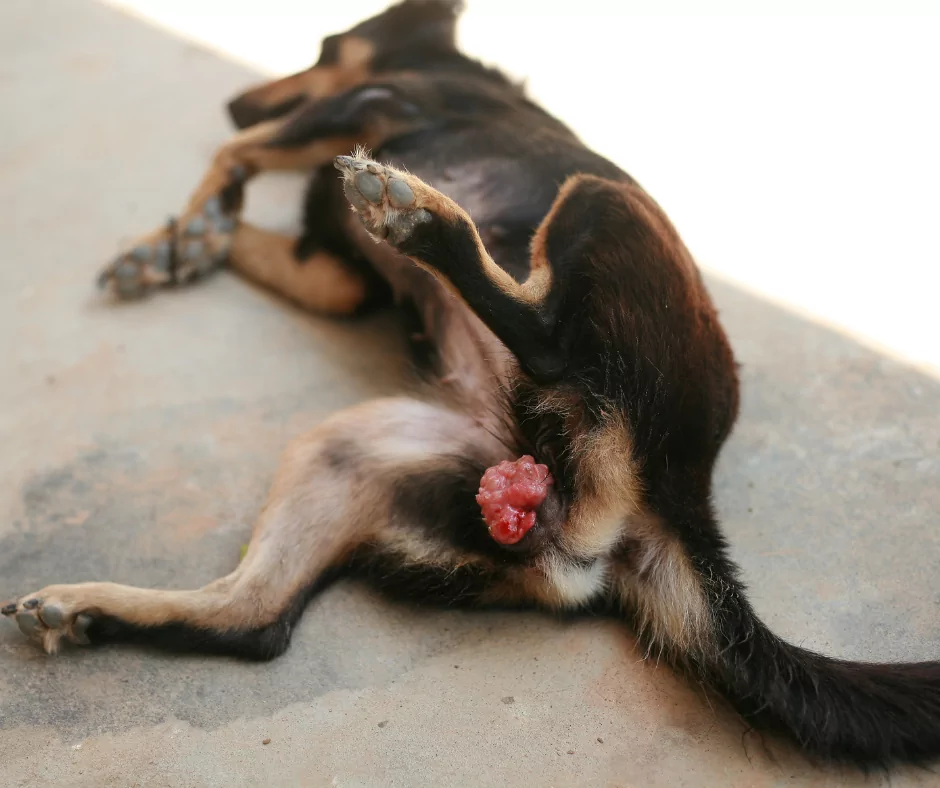What is Vaginal Prolapse in a Dog?

When a vaginal prolapse in a dog occurs it is seen as a swollen, doughnut-shaped vaginal tissue that is protruding from the vagina from the inside out.
Some of the causes for vaginal prolapse may include genetic predisposition, a proliferation of the vaginal mucosa (or vaginal hyperplasia), hormonal disbalance, or estrogen stimulation. Sometimes a vaginal prolapse may occur during labor from the continuous straining to push a puppy out. There are recorded cases of a vaginal prolapse due to disturbances while mating.
This can be very scary for the owner to see because it is not clear from the start what it may be. Sometimes, dogs get infected with a TVT (transmissible venereal tumor) that can resemble a vaginal prolapse when is big enough to protrude through the vagina.
This condition may affect any dog, but the breeds that are most commonly affected are Labradors, English Bulldogs, St Bernards, Mastiffs, Springer Spaniels, and Weimaraners.
What Are The General Symptoms of Vaginal Prolapse?
The most obvious symptom of vaginal prolapse is the protrusion of a pink or red inflamed mass from the vagina. The dog will be licking the area constantly and sometimes causing bleeding. Because of the inflamed area urination will be difficult or in some cases not possible for the dog. This will also affect possible mating even in days of heat.
Vaginal prolapse in canines is a relatively common disorder that affects dogs of various breeds, both male and female. It may have been caused by a surgical procedure or by another condition, such as chronic diarrhea. It can also result from natural causes, such as old age or neutering. Many cases of vaginal prolapse in dogs go undiagnosed because the animal neglects to show symptoms, such as those listed below.
Vaginal prolapse in dogs can be treated by surgical intervention when there is a noticeable bulge present, but it may recur if the underlying cause is not rectified. It’s possible for the protrusion to retract on its own if immediate surgery is not performed.
Symptoms that may indicate vaginal prolapse in dogs include:
The bulge is obvious to a human observer. If it is not visible, it can be felt by the owner or other companions. A change in the normal position of the clitoris is often a sign. It can be hard to determine if it’s a prolapse, when there are no other signs of injury to the vagina.
In dogs, the symptoms of vaginal prolapse include vaginal discharge. It can be of a mucus-like, bloody or pinkish/red color. It may be thick and appear lumpy in appearance with obvious signs of swelling. The dog may have difficulty urinating or moving around, because of a loss or gain of sensation or a protrusion in the genital area.
A dog with vaginal prolapse will often strain for a bowel movement, even if there is nothing to pass.
Dogs are known as man’s best friend, but this doesn’t just apply to those who walk on two legs! A surprising number of dogs need help with vaginal prolapse, too. Female dogs are also susceptible to different tumors of the female reproductive system.
Treatment of Vaginal Prolapse in Dogs
After careful consultation with a veterinarian and assessment of the severity of the vaginal prolapse, there are several approaches to treating this condition. One option is giving hormonal therapy to the dog to initiate estrus in order to reverse the prolapse. Also, some topical creams to keep the dog comfortable. In some cases with this therapy, the vaginal prolapse is treatable and very often reversed.
If the prolapse is so severe to block the urethra then hospitalization and surgical correction are necessary.
In the video below you can see a surgical correction of vaginal prolapse in a dog.
